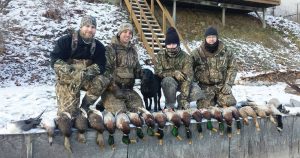Late season waterfowl hunting (The sequel)
Well, judging by the tsunami of Christmas car commercials dominating television I’m sure Santa brought each of you brand-new cars this year … right. Seriously, is there anybody you know who actually gives someone a car for Christmas? You can tune in any television channel and there they are, trying to make you think that everybody gets a car for Christmas. Sorry, but I really needed to get that off my chest.

When we last left our hero, he had just survived something totally moronic. He (I) had just about drowned himself and his buddy on Lake Ontario in January while trying to shoot a few diver ducks which, ironically, are terrible table fare. Many of the diver variety of ducks dive under the water for their food; their diet consists of crustaceans and tiny minnows that make their meat taste very gamey.
The late season waterfowler hunters are a wild bunch. There isn’t much they won’t do to shoot a duck or a goose. You could argue that they are even crazier than ice fishermen when it comes to their willingness to brave ferocious elements and chance their safety. A perfect example was hunters that were out during this past first week of the second half of the waterfowl season … in single digit temperatures. In the brutal cold I saw hunters in boats out in the middle of the Cayuga Lake and, I’m sure, there were hunters in the other Finger Lakes boat blinds as well.
We were able to hunt Cayuga Lake from shore this week with good success, but my son’s lab got so cold we had to put her in front of our portable heater for a good while to get her happy again. After opening day, which was this past Tuesday, December 26, the late season ducks get educated very quickly. Once they get shot at a few times, they become spooky and hard to decoy. It’s then a good time to make a switch to field goose hunting.
The goose hunting around New York State is fantastic at this time of year. With the weather so cold, geese get concentrated in certain areas where they have access to water that isn’t frozen to roost on at night and fields where they can still get at some feed during the day. The nice thing about goose hunting in January is that you usually don’t have to be on water. All you have to do is lay in the snow for four or five hours, that’s much saner. With the weather as cold as it was last week, most of the area geese have moved to the Finger Lakes area and are feeding in the surrounding corn fields. There is a state run co-op on the east side of Cayuga Lake with roughly 30 goose fields and a couple of water blinds. The local landowners have these open for hunting with the agreement that the state oversees all the hunting (http://www.dec.ny.gov/outdoor/71870.html). That area has thousands of geese using it now because on the north end of the lake is Montezuma National Wildlife Refuge. When the weather is cold enough to freeze Montezuma’s marshes, it pushes tens of thousands of ducks and geese off the refuge and south down onto Cayuga Lake where they have open water to roost on and many corn fields surrounding the Finger Lake.
If you want to DYI hunt and be successful, you need to scout. It is the absolute number one key to all successful waterfowl hunts, but especially on late season geese. Luckily for me I have a son who is an expert at this. I swear that the kid can find geese in a desert. It might possibly have something to do with me throwing a live goose into his crib when he was a baby. He now chases geese with a vengeance that borders on obsession.
The snag is that once you find the birds, you have to get permission to hunt that area, and figuring out who owns what is when it gets tough. There are very few large farms in this area and it seems that most fields are owned by one person and farmed by another, much larger farming operation. Small working farms are almost extinct. My son Joel puts in a ton of wheel time and with the help of the new mapping apps that show the property boundaries and landowners’ addresses, he usually finds a good honker field to hunt when we need one.
The hunting apps are the greatest thing to happen to the freelance waterfowler since the lay-out blind. With app in hand once you find the field the geese are using, the web site will not only show you the property lines but also the address of the landowner. Even a whitehead like myself can appreciate this technology. It’s then just a matter of dodging a farm dog or two and knocking on a few doors to get a yes. Now that deer season is over, it is much easier to get a yes from property owners to hunt geese.
It can be feast or famine during this late season waterfowling. You will either shoot your limit or be shut out completely; but when it works it can be the best hunting of the season. Just beware during the single digit cold temperatures, especially if there is water involved. If you are new to the sport I suggest you find an experienced waterfowler and beg your way in on a hunt. Volunteer that you will carry all the decoys, boats, motors, blinds, mojo decoys, heaters, guns and shells down to the shore blind and I’d bet they let you join them. The season only remains open until January 14 so grab every piece of warm clothing you own to get out there and run with the hard core waterfowlers. But be careful, you could get hooked if you don’t freeze first!
Provided information




